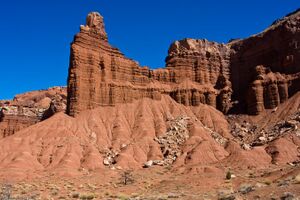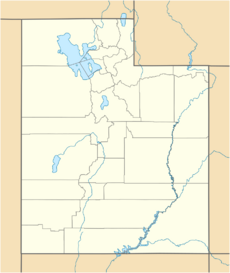Earth:Chimney Rock (Utah)
| Chimney Rock | |
|---|---|
 Chimney Rock, south-southwest aspect | |
| Highest point | |
| Elevation | 6,420 ft (1,960 m) [1] |
| Prominence | 80 ft (24 m) [1] |
| Parent peak | Mummy Cliff[1] |
| Isolation | 0.34 mi (0.55 km) [1] |
| Coordinates | [ ⚑ ] : 38°18′51″N 111°18′00″W / 38.3142290°N 111.2999938°W [2] |
| Geography | |
| Location | Capitol Reef National Park Wayne County, Utah, United States |
| Parent range | Colorado Plateau |
| Topo map | USGS Twin Rocks |
| Geology | |
| Age of rock | Triassic |
| Climbing | |
| Easiest route | closed to climbing[3][4] |
Chimney Rock is a 6,420-foot (1,960-meter) elevation summit located in Capitol Reef National Park, in Wayne County of Utah, United States.[2] This landmark is situated 2.5 mi (4.0 km) northwest of the park's visitor center, towering over 300 feet (90 meters) above Highway 24. Chimney Rock is also 2.5 mi (4.0 km) northwest of another of the park's landmarks, The Castle. Precipitation runoff from this feature ends up in the Colorado River drainage basin.[5] The Chimney Rock Trail is a 3.5-mile loop trail that takes hikers to a view of Chimney Rock from above Mummy Cliffs.
Geology
This feature is an erosional remnant composed of red sandstone of the Moenkopi Formation, topped with a Shinarump Conglomerate caprock of the Chinle Formation.[6] The Moenkopi Formation dates to about 245 million years ago, having formed during the Triassic. Long after the sedimentary rocks were deposited, the Colorado Plateau was uplifted relatively evenly, keeping the layers roughly horizontal, but Capitol Reef is an exception because of the Waterpocket Fold, a classic monocline, which formed between 50 and 70 million years ago during the Laramide Orogeny.[7]
Gallery
Climate
Spring and fall are the most favorable seasons to visit Chimney Rock. According to the Köppen climate classification system, it is located in a Cold semi-arid climate zone, which is defined by the coldest month having an average mean temperature below 32 °F (0 °C), and at least 50% of the total annual precipitation being received during the spring and summer. This desert climate receives less than 10 inches (250 millimeters) of annual rainfall, and snowfall is generally light during the winter. Script error: No such module "weather box".
See also
References
- ↑ 1.0 1.1 1.2 1.3 "Chimney Rock - 6,420' UT". https://listsofjohn.com/peak/22193. Retrieved 2020-09-26.
- ↑ 2.0 2.1 U.S. Geological Survey Geographic Names Information System: Chimney Rock
- ↑ Caitol Reef Rock Climbing, Utah.com
- ↑ Capitol Reef Rock Climbing and Bouldering, nps.gov
- ↑ "Chimney Rock, Utah". http://www.peakbagger.com/peak.aspx?pid=3858.
- ↑ Rick Stinchfield, Capitol Reef National Park The Complete Hiking and Touring Guide, Westcliffe Publishers, 2010.
- ↑ Capitol Reef Geology, NPS.gov
- ↑ "PRISM Climate Group, Oregon State University". http://prism.oregonstate.edu/explorer/.
External links
- Capitol Reef National Park National Park Service
- Chimney Rock Trail: National Park Service
- Chimney Rock: Weather forecast








